January 20 - 26, 2013: Issue 94
Noah's Ark (Shark) Incidents in Pittwater
With several reports of shark sightings in Pittwater this Summer, and witnessing the SLSC helicopter buzz one away from the Annual Palm Beach Surf Life Saving Club Open Carnival a few weeks ago, it seems timely to continue our Saltwater Summer mix for January by sharing a few encounters from our past. The estuary and its beaches have always been the abode of these creatures. They come closer to shore chasing fish and have entered the estuary in centuries past following or chasing the schools that came in season to inhabit these waters.
Sharks being reported in McCarr's creek, Scotland Island residents who relate seeing them circling the island thirty years ago, even the first European settlers who named 'Shark Point' on the Barrenjoey headland due to seeing schools of them, point to a long observation of these fish. The anecdotal history page run a few weeks ago, valuable for its naming of some of the vessels in the original Pittwater-Broken Bay Mosquito fleet, Canoe and I Go With The Mosquito Fleet, spoke of a 'Billy' who was well known to locals as an estuary visitor.
An inside the estuary incident:
FIGHT WITH SHARK IN CAREEL BAY. FISHERMEN'S EXPERIENCE.
The story of an exciting fight with a tiger shark in Careel Bay, near Palm Beach, was told yesterday by Mr D K Edgar, of McLennnn and Connor Sydney woolbuyers who with Mr Henry Monckton. a Sydney woolbuyer, and his brother Mr Basil Monckton, succeeded in landing the shark after a struggle lasting nearly two hours. The struggle was witnessed by hundreds of holiday-makers, who witnessed the rare spectacle of a sea monster dashing to and fro about the bay in utter frenzy and at last, almost exhausted being landed and dispatched with the aid of an axe. The captive weighed about 600lb and measured 11ft 9in.
The tiger shark Is one of the most ferocious of its genus. The captured specimen had four rows of teeth in each of its jaws, and when it was opened up the remains of what had been a large-sized dog were found in its inside. A shark line baited with a small shark was set overnight, and the following morning Mr Henry Monckton found that about 80 yards of line had been taken out. He jumped into a 16ft ship's boat and unfastened the line from a post. Immediately he was towed out at it startling speed to the centre of the bay. He gave the alarm and his brother and Mr Edgarr set out in pursuit in a dinghy one armed with a rifle and the other with harpoon. They reached the larger boat and Mr Basil Monckton took charge of the oars and ' backwatered ' to steady the shark’s speed, whilst Mr Henry Monckton ' played" the captive und Mr Edgar looked after the dinghy.
For over an hour the shark fought dashing across the bay hither and thither and swirling the water, its trail of lashed waters resemblling the track of a steamer. Gradually the amateur fishermen worked the monster into shallow water. Then Mr Basil Monckton leapt out of the boat and raced ashore with the line, whilst his brother secured the harpoon, struck the monster with it, and twisted it in the body as much as his strength would allow. The shark was then hauled on to the beach.
During the struggle It was noticed that two pilot fish, one about 15 Inches long and the other about five inches, appeared to be greatly perturbed. They swam about with their guardian, and accompanied the monster right up to the bench, the smaller one being secured by Mr. Edgar. The larger one swum about the beach for at least two hours after the final stage of the fight. One of the most remarkable incidents was that when the shark raised his body out of the water the pilot fish jumped on to his back. They appeared to have a real affection for the monster, and the manner in which they swam close into the shore after it had been landed excited the keen interest of the many spectators who came to view it. FIGHT WITH SHARK. (1926, January 7). The Sydney Morning Herald (NSW : 1842 - 1954), p. 10. Retrieved from http://nla.gov.au/nla.news-article16267239
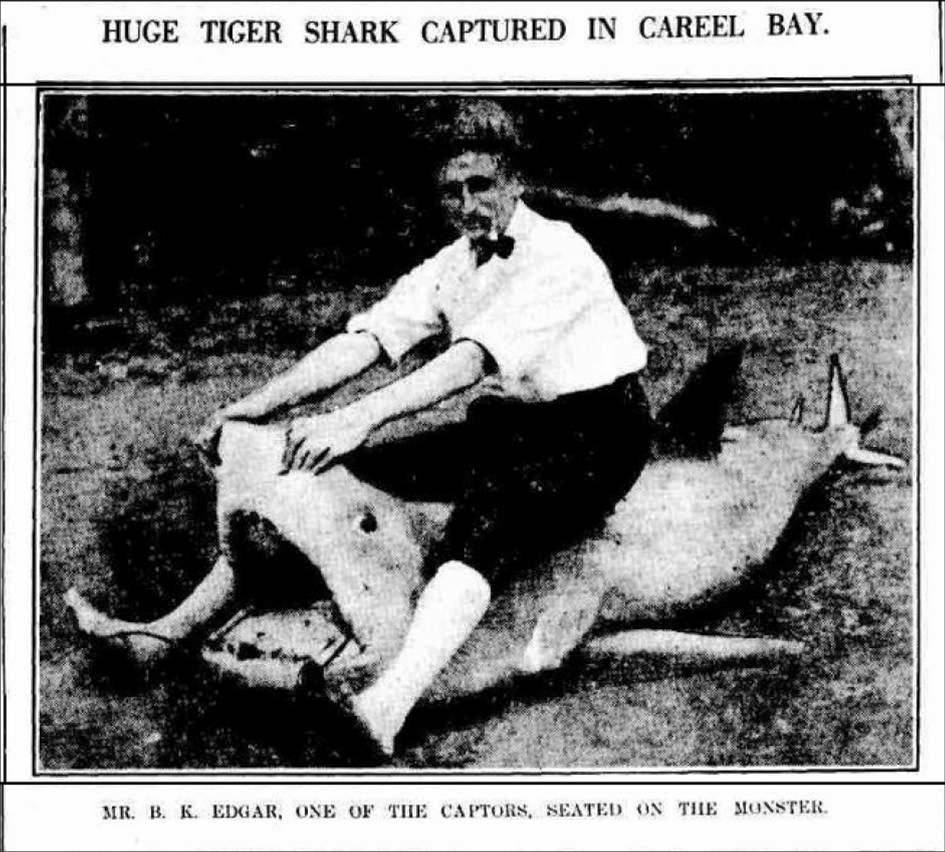
HUGE TIGER SHARK CAPTURED IN CAREEL BAY. (1926, January 7). The Sydney Morning Herald (NSW : 1842 - 1954), p. 10. Retrieved from http://nla.gov.au/nla.news-article16267219
Tiger sharks can live for up to 50 years in the wild and develop long relationships with their ‘pilot fish’ cleaners:
The pilot fish (Naucrates ductor) congregates around sharks, rays, and sea turtles, where it eats ectoparasites on, and leftovers around the host species. The pilot fish's relationship with sharks is a mutualistic one; the pilot fish gains protection from predators, while the shark gains freedom from parasites. It was often said by sailors that sharks and pilot fish share something like a "close companionship"; there were even tales of this fish following ships which had captured "their" shark for up to six weeks and showing signs of distress in its absence. (Gudger, E. W. (March 1929). "Some Instances of Supposed Sympathy Among Fishes". The Scientific Monthly 28 (3): 267.) (1.)
By 1930 most Pittwater beaches had shark towers and bells installed. Lifesavers also had whistles in order to warn people to leave the surf once a shark had been spotted. A small sample of these encounters demonstrates the 'above and beyond' nature of local lifesavers, the tragic circumstances that can accompany these incidents and how people will fight back:
SURF THRILLS TRAGEDY AT NARRABEEN.SHARK RUSHES AT RESCUERS
Sunday was one of the most sensational days in the history of surfing at Sydney. Lives were imperilled on many beaches, and surfers in danger were rescued by the score. There was a tragic drowning at North Narrabeen, the victim being W. Dawe, aged 25, of North Sydney. 'According to an eye-Witness, the remarkable part of the heroic attempt at North Narrabeen was the fact that the five men who tried to save Dawe did not lose their own lives. Dawe was carried out with another man named R. Brothers at 5.30 p.m. W.Lloyd, beach inspector, was the last of the patrolmen of the club to leave the beach, and he did not go until ha saw that all bathers had left the water. Dawe and Brothers must have gone into the water just after the patrolman had left. Apparently Dawe was swept out as soon as he entered the water, for Wilfred Gay, a well-known Rugby Union footballer, and a friend, strolled onto the beach and saw the two swimmers being carried out. Gay and the other man were dressed in '' whites,'' but they rushed to the rescue. Gay donned the belt. Brothers, though caught by the current himself, tried to help Dawe, who clutched hold of him and forced him under the water. Exhausted, he had to let Dawe go, and he was swept further out. Gay, after a tiring swim, reached Brothers and brought him to the shore. He set out again to rescue Dawe, but the swim through the breakers in the belt was too much, and, after getting into heavy water, he could make no progress. In the meantime somebody had rushed to the surf shed and rung the alarm bell. By a stroke of fate he rang the bell at practically the same time as the dinner gong of a nearby boarding house is sounded. The bell and the gong have a similar tone, and members of the Narrabeen Club, who we're not far from the beach, at first mistook the bell for the gong. They did not realise what was wrong for a few minutes, but when the ringing continued a crowd raced to the beach. W. A. Grose, J. Cameron, Tas. King, Wally Proudfoot, and Tom Gallacher, five of North Narrabeen Club's best swimmers, rushed into the water. They were told that a man had been carried out, and had disappeared, and saw Gay still gallantly battling through the surf. Grose swam out to Gay, took the belt from the exhausted swimmer, and tried to get out through the heavy seas. King, Cameron, Proudfoot, and Gallacher swam out with him, King also being in a belt. The two beltmen quickly realised that they had no chance of pulling the line through the sweeping current, and soon discarded the belts, but continued swimming to sea. The five swimmers were fighting against great odds. Big waves broke over them and forced them under, but they slowly forged ahead. Eventually they got clear of the surf, and, swimming almost abreast, struck out to deepwater, where Dawe had disappeared. They made a long search, and, finding no trace of the body, swam back to the beach.
After resting they set out again. After, a second battle through the seas they got out beyond the breakers. They swam about for a long while, and then decided their quest was hopeless. In the meantime, W. Schultz (who took the sweep) and others, ran out the surf boat. They got through the breakers—a remarkable feat—and cruised around searching for the body. The five swimmers had struggled back to the shore a second time when somebody said that ho had seen the body floating just under the waves far out from the beach. What he thought was the body was a shark. Though they were practically exhausted from the buffeting they had received, the same surfers raced into the water again, and though the spectators thought they had no possible chance of getting out, so exhausted did they seem, they reached deep water once more. While swimming along slowly Proudfoot passed over a seven-foot shark. So close was it that he could almost touch it. He was horrified to see it turn and rush towards King, who was treading water. Shouting out an alarm, Proudfoot commenced -thrashing the water, and the others did the same. Then, bunching together, they struck out for the shore, fearing at any moment the shark would attack them. They had just enough strength left to reach the breakers, and then practically let themselves be washed to the beach. In the three attempts at rescue the five men were nearly on hour in the water. SURF THRILLS. (1926, December 7). Singleton Argus (NSW : 1880 - 1954) , p. 2. Retrieved from http://nla.gov.au/nla.news-article81086486
SHARK ATTACK NORTH NARRABEEN Lone Surfer Killed.
Herbert McFarlane, 22, of Toelle-street, Rozelle, a well-known footballer, was attacked by a shark and fatally injured while swimming alone at North Narrabeen beach at dusk on Saturday. Immediately his agonised screams were heard three members of the local surf club raced into the water to his aid and dragged his mangled body ashore. McFarlane was rushed to Manly Hospital by ambulance, but
he was dead upon arrival. McFarlane's death brings the steadily-mounting number of shark attacks along the New South Wales coast since 1919 to 24. This season alone five swimmers have died in the metropolitan area consequent upon attacks by sharks—the biggest number of tragedies in any one season. SHARK ATTACK. (1935, March 4). The Sydney Morning Herald(NSW : 1842 - 1954), p. 9. Retrieved from http://nla.gov.au/nla.news-article17157896
SHARK SCARE AT NARRABEEN. SYDNEY, Friday.
A crowd of about 200 called out to lifesavers at North Narrabeen today for about five minutest to draw attention to sharks between the lifesavers and the beach. About 60 bathers left the water at Newport when several sharks were seen about 100 yards from the shore. SHARK SCARE AT NARRABEEN. (1944, January 15). The Canberra Times (ACT : 1926 - 1995), p. 4. Retrieved from http://nla.gov.au/nla.news-article2665541
FOUR SHARK CALLS AT NARRABEEN Four shark alarms were given at Narrabeen yesterday morning. There were few surfers in the water at the time. All left the water hurriedly. A ten-foot shark was caught near the baths at Picnic Point, George's River, yesterday morning. The catch was made by Mr. J. Baxter, of Picnic Point, and was seen by people in the baths. The shark had apparently been cruising nearby for several days. FOUR SHARK CALLS AT NARRABEEN. (1947, January 7). The Sydney Morning Herald (NSW : 1842 - 1954), p. 3. Retrieved from http://nla.gov.au/nla.news-article27903967
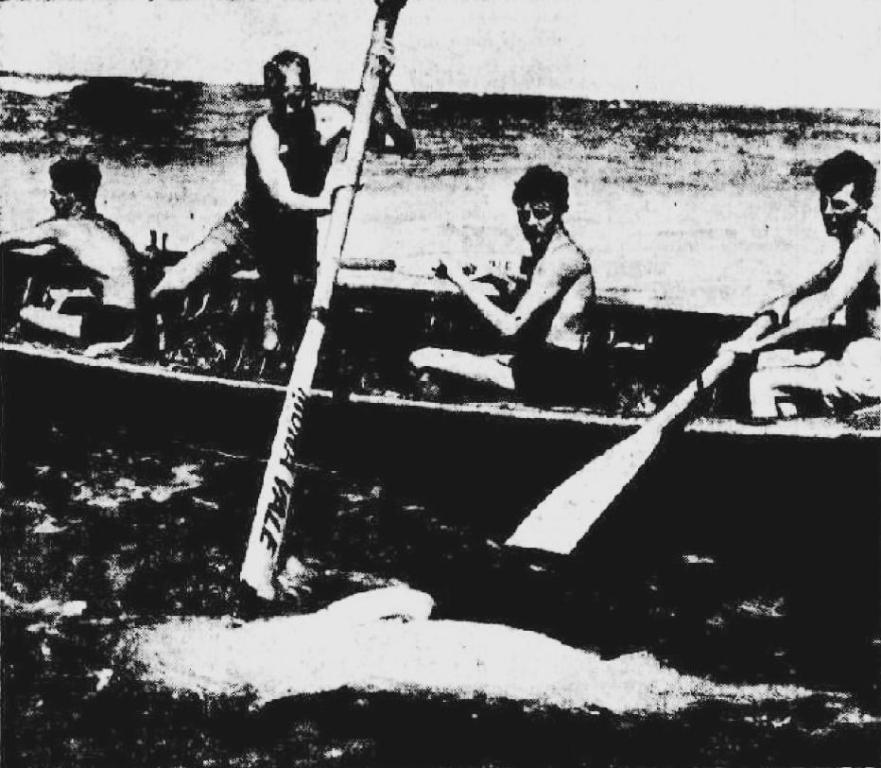
NOVEL CAPTURE OF SHARK BY FIVE MONA VALE LIFESAVERS
TOP: Frank Spencer, of Mona Vale's junior surfboat crew, shows how he stunned a shark by jabbing an oar into its gill. Others in the boat from left are: John Windshuttle, Neil Mason, and Noel Mason.
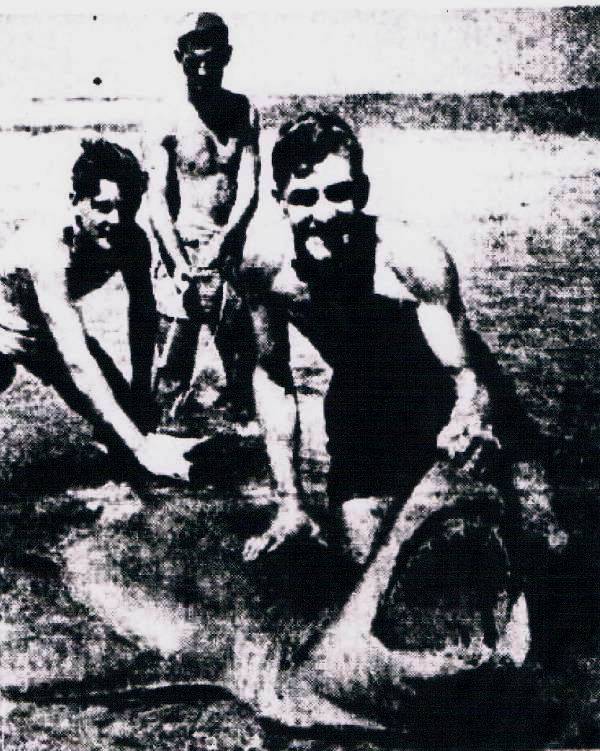
BOTTOM: A lifesaver holds open the shark's jaws.
NOVEL CAPTURE OF SHARK BY FIVE MONA VALE LIFESAVERS. (1949, February 28). The Sydney Morning Herald(NSW : 1842 - 1954), p. 1. Retrieved from http://nla.gov.au/nla.news-article32153295
SHARK AT NEWPORT
Many surfers were indifficulty at Newport where channels formed at each end of the bathing area. Eight people swept into the channels In the morning were rescued by belt men after they had been carried about 100 yards from the shore. One man did not recover until he had been treated by ambulance men for two hours. Many other surfers were rescued from shallower water. About 4pm the current changed and 25 people were carried out simultaneously. Five beltmen, Messrs. S. Roberts, W. Dickey, R. Smallwood, D. Smith and W Birrell swam ou.t Each beltman brought in two 0r three of the frightened surfers at a time until they all reached safety. There were several other rescues. About 5 10 pm u large shirk appeared close inshore. Three surfers were far out. Two of them took a shoot and reached the beach. The third, a girl, became panic-stricken. She took a small shoot which left her in one of the channels. Mr C Darcy swam out and brought her ashore. The shark cruised along the beach several times before disappearing. HOLIDAY SPENT IN THE OPEN. (1938, January 4). The Sydney Morning Herald (NSW : 1842 - 1954), p. 6. Retrieved from http://nla.gov.au/nla.news-article17421189
SHARK SCARES AT SYDNEY BEACHES SYDNEY. December 28— A 16foot grey nurse shark closed Newport Beach thiss afternoon, and sharks also caused alarms at Bondi and Curl Curl. The Newport lifesavers had difficulty in warning surfers because the wind carried away the sound of the bell. Surfmen dashed into the water with bags and whistles. SHARK SCARES AT SYDNEY BEACHES. (1947, December 29). Townsville Daily Bulletin (Qld. : 1885 - 1954), p. 1. Retrieved from http://nla.gov.au/nla.news-article62907400
SEA FIGHT AT AVALON - Shark Loses To Dolphins. Three thousand people at Avalon beach yesterday watched a fight between a large shark and two dolphins, in which the shark had the worst of the encounter. The dolphins drove the shark in toward the beach and attempted to tear strips of flesh from it in a struggle which lasted nearly half an hour.
During the fight, onlookers were thrilled as they saw the dolphins leap clear of the water and then fall back with great splashes. Soon after lunch, the shark alarm was sounded and about 400 surfers rushed from the water. They saw a large shark swimming toward the beach with the two dolphins closely pursuing it. The fight took place less than 200 feet from the beach. Finally the shark headed out to sea, still pursued by the dolphins. SEA FIGHT AT AVALON. (1947, February 24). The Sydney Morning Herald (NSW : 1842 - 1954), p. 1. Retrieved from http://nla.gov.au/nla.news-article18007182
FOUGHT SHARK OFF WITH PADDLE SYDNEY, Sunday.- Lashing furiously with his paddle, 17-yearold Ross Fountain frightened off a 12-foot shark which had tossed him from his surf ski at Newport yesterday. Fountain was 200 yards from the shore when the shark swam beneath the ski and threw him off. He climbed back on the up-turned ski and lashed at the shark with the paddle. Two men on surf skis arrived and helped to frighten - the shark away. FOUGHT SHARK OFF WITH PADDLE. (1949, February 28).Advocate (Burnie, Tas. : 1890 - 1954), p. 2. Retrieved from http://nla.gov.au/nla.news-article69330825
Shark Scrapes Avalon Surfer's Board A 14-foot shark dashed straight at a young surfboard rider at Avalon yesterday, dived under the board at the last second, scraping the board as it passed. The rider, Max Watt, 17, was 400 yards out from the beach. He kept his balance, and was lucky to catch a big wave, immediately after which he rode right in to the shore. Watt, a member of the Avalon Surf Club, first saw the shark when it was about 50 yards from him. He lost sight of it as it apparently dived. A moment later he saw it coming straight towards him at top speed. When Watt got ashore he gave the alarm. The shark cruised around for a time, then swam off to the north. Two big sharks kept 1,000 Coogee surfers on the beach for half an hour. The sharks came close inshore, following a big school of mullet, which was circling in an attemptto escape. - Shark Scrapes Avalon Surfer's Board. (1947, April 7). The Sydney Morning Herald (NSW : 1842 - 1954), p. 1. Retrieved from http://nla.gov.au/nla.news-article27898982
Surf Boat Convoyed by Sharks
Sydney, Feb. 18.— Twenty grey nurse sharks formed a convoy for an Avalon surf boat which was being rowed to Whale Beach late to-day. When a mile off the coast from Avalon, on their way to return the surf boat to Whale Beach, the three life-savers in the boat found themselves surrounded by the sharks They were without a harpoon or any other defence.
The sharks moved slowly and cruised with the boat for the full distance. Members of the crew said afterwards that they believed they made record speed.Surf Boat Convoyed by Sharks. (1948, February 20). Kalgoorlie Miner (WA : 1895 - 1950), p. 5. Retrieved from http://nla.gov.au/nla.news-article95569748
With all these attacks, some fatal, the idea of Shark Nets being installed off Sydney beaches arose:
SHARK NETS FOR BONDI. Special precautions are being taken at the Bondi beach. Sydney, to protect surf-bathers from sharks, in view of several recent tragedies. Experiments are being made with steel nets, buoyed by huge steel drums. ' SHARK NETS FOR BONDI. (1929, March 2). The Argus(Melbourne, Vic. : 1848 - 1956), p. 17. Retrieved from http://nla.gov.au/nla.news-article3994263
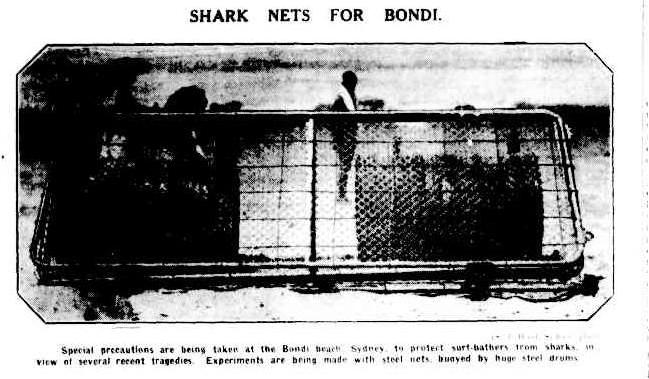
These contraptions, similar to what is used today by distance swimmers, soon became a good idea:
Swims Eight Miles: Shark-proof Nets Used. Sydney, March 8. Miss Lily Copplestone, of New Zealand, swam this afternoon from Neutral Bay to Manly, about 8 miles, in 3 hours 6 mins. 21 sec. Miss Irene Rolfe, of Bondi, also completed the swim. Her time was 4 hrs. 25 mins. Two separate shark-proof nets, towed by two launches, were used. Miss Copplestone swam strongly all the way. She will leave soon for England, where she will attempt to swim the English Channel. Swims Eight Miles: Shark-proof Nets Used. (1931, March 12).Chronicle (Adelaide, SA : 1895 - 1954), p. 43. Retrieved from http://nla.gov.au/nla.news-article90490165
Marathon dances, swims, cycle rides...anything that required stanima, were very popular during the Depression era. According to Manly Local Studies, 10, 000 people lined the harbour shore of Manly to witness the end of this race.
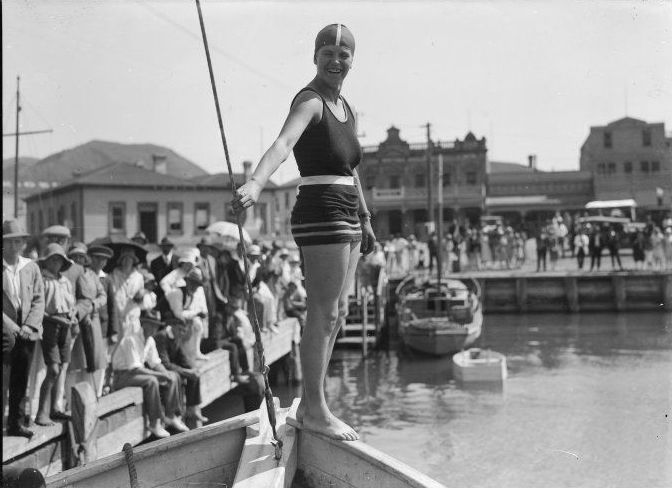
Lily Copplestone before her attempt to swim Cook Strait, taken 1929 by Sydney Charles Smith (1888-1972). Reference Number: 1/2-046117-G, courtesy of the Alexander Turnbull librray, NZ.
With the proposed introduction of shark nets along beaches and to protect swimmers at inner waterways and harbour pools came debate:
INNER BASIN, PITTWATER. In a letter to the Editor of the "Herald," Mr. A. C. Cooke appeals to yachtsmen to oppose the reported decision of the Kuringgai Chase trustees to close the Inner Basin, Pittwater, to all boats, irrespective of size, in order that they might convert the basin into a huge swimming pool, protected by a shark proof net. INNER BASIN, PITTWATER. (1934, November 6). The Sydney Morning Herald (NSW : 1842 - 1954), p. 10. Retrieved from http://nla.gov.au/nla.news-article17130565
INNER BASIN, PITTWATER. The executive committee of the Amateur Swimming Association has decided to support the action of the Kuring-gai Chase trustee in closing the inner basin at Pittwater to yachts and other craft, in order to convert the area into a large swimming basin by the erection of a shark-proof net. INNER BASIN, PITTWATER. (1934, November 24). The Sydney Morning Herald (NSW : 1842 - 1954), p. 22. Retrieved from http://nla.gov.au/nla.news-article17112922
Shark nets were installed for an experimental period of two years and then a budget for them was suspended for a while. During WWII they were removed from ocean beaches although kept in place at harbour pool areas.
McKell (Premier) Asked To Check McKell (Treasurer) The Premier, Mr. McKell, will be asked to over-rule a decision of the Treasurer. Mr. McKell is also Treasurer. Municipal councils and the Surf Lifesaving Association will ask the Premier to overrule the Treasurer's decision not to make money avail-able for shark meshing off Sydney's beaches this summer. The Treasurer has ruled that funds are required for more important projects and has informed Manly Council and Mr. D. P. MacDonald, M.L.A., of his ruling. Manly Council has refused to accept the decision as final, and has sought the co-operation of other councils, as well as enlisting the aid of the Surf Association. Surf Association officials yesterday emphasised the value of shark meshing along the beaches.
Thousands of sharks were caught, and danger to life was reduced considerably, they said. A private company operating on a commercial basis on northern beaches has already secured good hauls. Most recent catch was an 18ft shark off Newport, 100 yards from the bathing area. McKell (Premier) Asked To Check McKell (Treasurer). (1945, November 9). The Sydney Morning Herald (NSW : 1842 - 1954), p. 3. Retrieved from http://nla.gov.au/nla.news-article17959046
SHARK-PROOF NETS Government to Consider. SYDNEY, Tuesday.
The question whether the State Government will undertake the meshing of the surf beaches as a protection against sharks is to be investigated, according to a statement made by the Minister for Local Government (Mr. Spooner),to-day. Mr. Spooner said that if the Government did undertake the meshing of the beaches it might be that private companies would purchase all the sharks caught. Certainly the Government would not be interested in establishing an industry, which was the function of private enterprise. SHARK-PROOF NETS. (1937, July 7). Northern Star (Lismore, NSW : 1876 - 1954), p. 3. Retrieved from http://nla.gov.au/nla.news-article94695001
In Pittwater Shark nets are installed at most of the estuary ‘baths’. Although a 2009 Department of Primary Industries Report re-endorsed the use of shark nets, and aerial contractors warn of a build-up of sharks off our coastline, as evidenced by the number of attacks and reported sightings this season, some state these nets are ineffective, sitting two metres below the surface of the sea in order to not damage vessels and that most sharks caught in them are inside, not kept out. They are also cited as cruel to other marine creatures, catching and killing them instead of sharks.
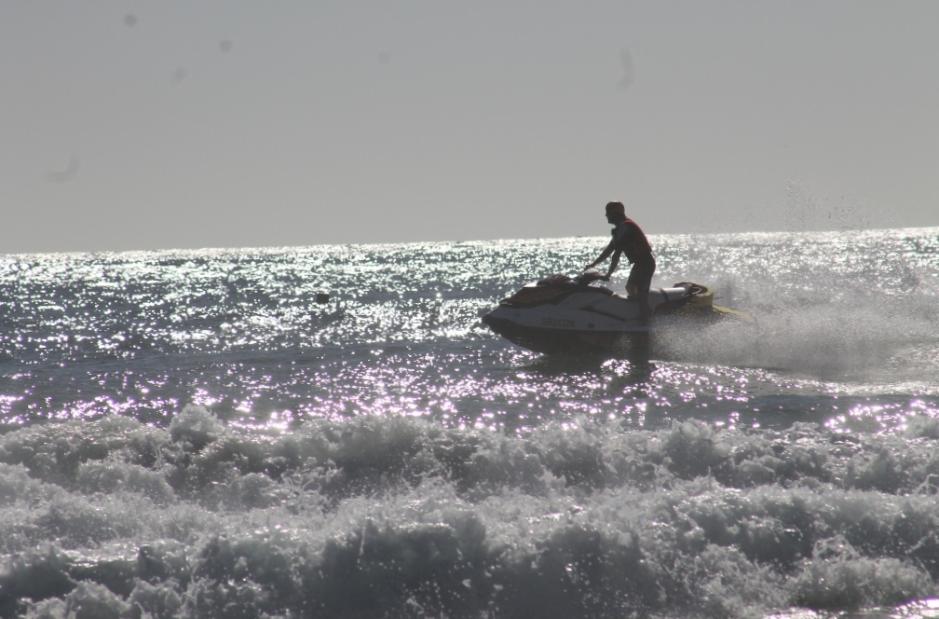
Modern method: order people out of the water, create loud noise with all available watercraft until shark moves away, monitor via helicopter: allow people back into water when area is safe. Taken at Palm Beach Open Carnival, 2013. Pictures by A J Guesdon.
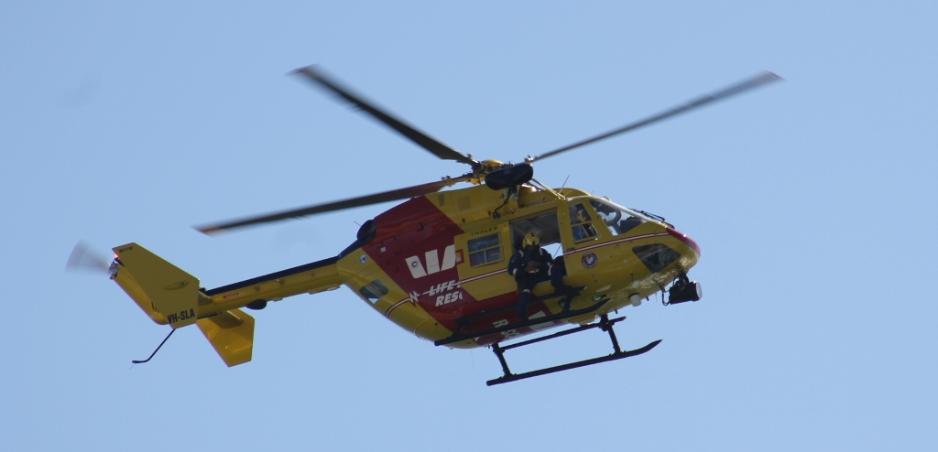
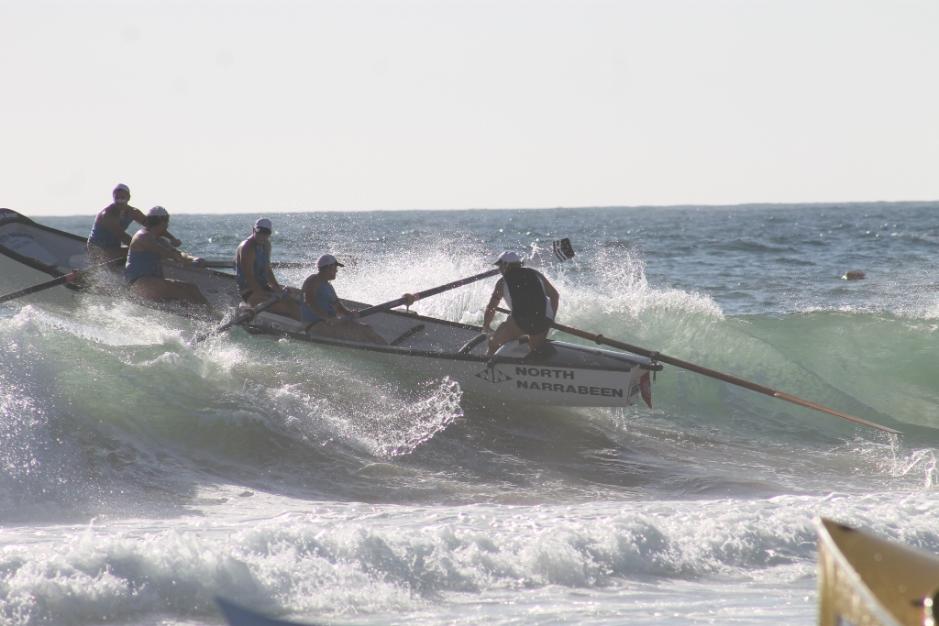
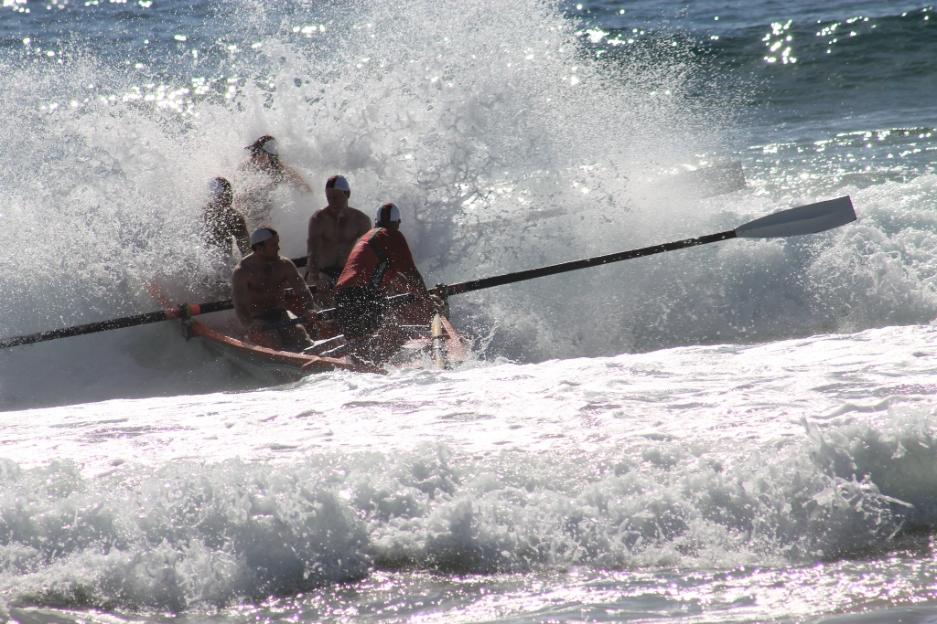
Shark Encounters in Pittwater threads collected and collated by A J Guesdon, 2013.